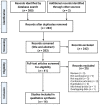A Scoping Review of West Nile Virus Seroprevalence Studies among African Equids
- PMID: 34358049
- PMCID: PMC8308515
- DOI: 10.3390/pathogens10070899
A Scoping Review of West Nile Virus Seroprevalence Studies among African Equids
Abstract
West Nile virus (WNV) is an emerging and re-emerging zoonotic flavivirus first identified in and endemic to Africa. The virus is transmitted between birds by biting mosquitoes, with equids and humans being incidental hosts. The majority of infected incidental hosts display no or only mild clinical signs, but a fraction develop encephalitis. The aim of this scoping review was to identify and evaluate primary research on the presence of antibodies to WNV among African equids. Three bibliographic databases and the grey literature were searched. Of 283 articles identified, only 16 satisfied all the inclusion criteria. Data were collated on study design and outcomes. The overall seroprevalence reported ranged from 17.4 to 90.3%, with 1998 (35%) of the 5746 horses, donkeys and mules having screened positive for WNV antibodies. Several articles determined that seroprevalence increased significantly with age. Due to co-circulation of other flaviviruses in Africa, in the majority of studies that screened samples by ELISA, positive results were confirmed using a more specific neutralization test. However, only eight studies tested against other flaviviruses, including Potiskum, Uganda S, Wesselsbron and yellow fever virus in one, Japanese encephalitis and Usutu virus (USUV) in one, tick-borne encephalitis and USUV in one and USUV only in three. Equids are regarded as useful sentinel animals for WNV, but variation in study design poses challenges when trying to determine risk factors for, and trends in, WNV seroprevalence.
Keywords: Africa; West Nile virus; antibodies; donkeys; flavivirus; horses; mules; seroprevalence.
Conflict of interest statement
The authors declare no conflict of interest.
Figures


References
-
- Maclachlan N.J., Dubovi E.J. Chapter 29: Flaviviridae. In: MacLachlan N.J., Dubovi E.J., editors. Fenner’s Veterinary Virology. 5th ed. Elsevier Academic Press; London, UK: 2017. pp. 525–545.
-
- Smithburn K., Hughes T., Burke A., Paul J. A neurotropic virus isolated from the blood of a native of Uganda. Am. J. Trop. Med. Hyg. 1940;1:471–492. doi: 10.4269/ajtmh.1940.s1-20.471. - DOI
Publication types
LinkOut - more resources
Full Text Sources

